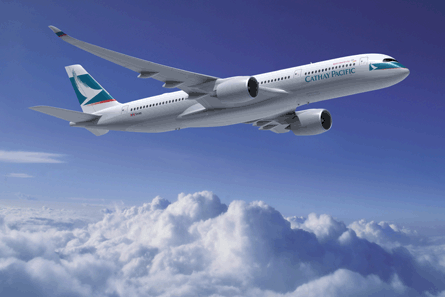It has been a spectacular turnaround for Cathay Pacific over the last month, with the oneworld carrier announcing strong profits, confirming details about its future fleet plans, and increasing capacity as demand returns in the Asia-Pacific airline market.
This time a year ago it was all very different. The carrier then reported a net profit of HK$812 million ($105 million), but only on the back of a HK$2.1 billion gain from fuel hedging as revenues fell 27%. As late as November 2009, chief executive Tony Tyler was warning it must relook at the "resilience" of its business model in light of the crisis.
In August, however, Cathay's profits for the first half of 2010 surged seven-fold to HK$6.8 billion on a 34% jump in turnover to HK$41.3 billion. Even after allowing for one-off gains from the sale of its stake in MRO firm Hong Kong Aircraft Engineering, analysts generally agree that it was a fantastic result.
 |
|---|
"The results are much higher than expected and beat all forecasts on the street," says Jim Wong an analyst at Nomura International. "Cathay is likely set for a record profit year even after stripping away exceptional gains." Kelvin Lau, an analyst at Daiwa Capital Markets, adds: "The robust rebound in earnings shows that a recovery of the industry is in place, supported not only by strong cargo demand but a gradual comeback of premium passenger air services."
After cutting capacity over the last two years as demand plummeted and reconfiguring some aircraft to reduce the number of premium seats, Cathay now says it will increases passenger capacity about 4% from later this year and return to pre-crisis levels.
Several decisions, aimed at focusing the airline on the core air transport and cargo businesses over the next few years, have been made. In June, Cathay sold its 15% stake in HAECO to parent Swire Pacific for HK$2.62 billion, and offloaded its 10% interest in Hong Kong Air Cargo Terminals for HK$640 million in May.
Some of the proceeds will go towards the construction of Hong Kong International Airport's new HK$5.5 billion cargo terminal, which resumed earlier this year and should come online in 2013. Cathay is bringing back into service five Boeing 747-400 converted freighters that were parked in 2009 as the cargo market recovers. Its Shanghai-based cargo joint venture with Air China is due to start operations this summer, while the airline will begin taking delivery of 10 747-8 freighters from January 2011.
Cathay has also firmed up its fleet plans, signing a letter of intent to buy 30 Airbus A350-900 aircraft and exercising rights for six Boeing 777-300ERs. Cathay says the A350s, for delivery between 2016 and 2019, will "form the backbone" of its future mid-sized wide-body fleet and operate across its route network, including on non-stop flights to Europe and North America.
Perfect Fit
"The A350-900 is a perfect fit for the development of our fleet - a mid-size long-haul aircraft that is fuel efficient, environmentally friendly and provides the kind of capacity, range and operating economics that we need to complement and enhance our existing fleet," says Tyler.
That, however, is unlikely to be the end of its orders, with a decision between the ultra-large Airbus A380 and 747-8I expected in the coming years. Cathay, which operates 15 A340-300s and 22 747-400s, says it does not plan to replace the entire fleets of these types with the new aircraft that it has ordered, but "only the older ones". Airbus forecasts that Hong Kong will be the world's top hub for movements of ultra-large aircraft over the long term and remains convinced that Cathay will buy the type. "It is a question of timing. Looking at the big picture, I'll bet that in five years' time Cathay will have ordered by then," says A380 marketing chief Richard Carcaillet.
Despite the optimism, two challenges remains. One is fuel price volatility and the other is a return to the recessionary economic conditions of 2008 and much of 2009. Both, says Cathay's chairman Christopher Pratt, could "adversely affect" the bottom line very quickly.
But after two tough years there finally appears to be some clear skies. "We remain confident in the long-term future of the Cathay Pacific Group and Hong Kong. We are in a challenging and unpredictable industry and we have to be mindful of the many things - economic fluctuations, rising fuel prices, even volcanic eruptions - that can quickly have an impact on our business," says Pratt. "Nevertheless, we have a number of things working in our favour, including our capable, supportive and committed team, a superb international network, effective management of costs, our quality service and product offering, a strong relationship with Air China and our position in Hong Kong - one of the world's great cities and a premier international aviation hub."
For more on Asia's strong contribution to the market recovery see our recent analysis
Source: Airline Business



















